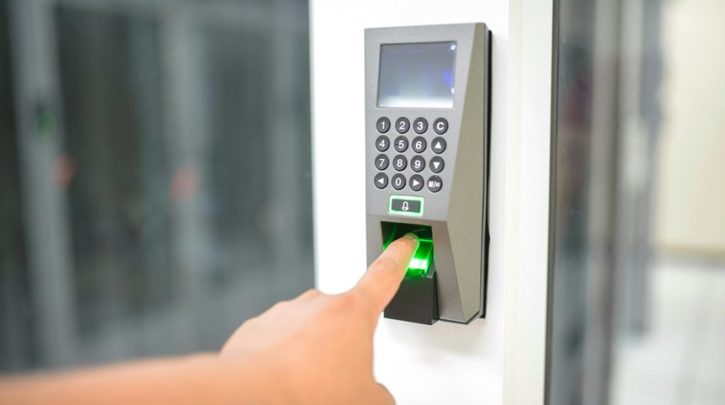When choosing a smart door lock with fingerprint and app control, you want a device that balances security and convenience. Look for models offering reliable biometric sensors, easy app interfaces, and remote management features. Consider how many fingerprints you can register and whether you can grant temporary access through the app. Also, check compatibility with your home system and battery life. These factors can make a big difference in daily use and peace of mind. But which lock fits your needs best?
Top Smart Locks Featuring Fingerprint and App Access
Smart locks that combine fingerprint recognition with app access give you flexible and secure ways to control your door.
These devices enhance user authentication by offering biometric verification alongside app-based entry, ensuring only authorized individuals gain access.
Models like the Kwikset Halo Select and Lockly Visage excel in device integration, allowing you to manage access remotely and monitor activity in real time.
Many smart locks, including the Ultraloq Bolt, let you register multiple fingerprints, accommodating family or trusted guests easily.
This combination of fingerprint and app access balances convenience with strong security for your home.
Key Security Features to Consider
Having reliable access methods like fingerprint and app controls is a great start, but you also need to focus on the security features that protect your lock from threats.
When choosing a smart lock, consider these key factors:
- Confirm it meets ANSI grade 1 or 2 for smart lock durability, providing strong resistance against forced entry.
- Verify it uses advanced encryption standards to secure wireless communications and prevent hacking.
- Look for tamper alerts and regular firmware updates to stay ahead of vulnerabilities and unauthorized access attempts.
These features help keep your home safe and your smart lock reliable.
Multiple Unlocking Methods for Convenience
While convenience is a key benefit, multiple opening methods also improve your daily experience by giving you flexible options to access your home.
Smart locks combine user friendly features like fingerprint scanners, keypads, and app control to enhance your user experience.
Fingerprint recognition lets you gain entry to doors instantly with a touch, while keypads offer easy code entry.
Many models also include auto-unlock, which senses when you’re nearby and opens the door automatically.
This variety guarantees you always have a reliable way in, making your routine smoother and more secure without compromising ease of use.
Remote Access and Control Capabilities
Beyond just multiple opening methods, many modern door locks give you the ability to control and monitor access from anywhere using your smartphone.
Remote monitoring lets you see who enters and when, enhancing your home’s security. With app-based access control, you can:
- Release doors remotely to welcome guests or service providers.
- Share temporary access codes for specific times without handing out physical keys.
- Receive real-time notifications and track activity logs to stay informed.
These features combine convenience with peace of mind, ensuring you manage your home’s security efficiently, no matter where you are.
Connectivity Options and Their Impact
You’ll want to weigh the differences between Wi-Fi and Bluetooth when choosing a smart lock, since Wi-Fi lets you control it from anywhere while Bluetooth works best up close.
Thread technology is gaining attention for its energy efficiency, helping your lock last longer on a single battery.
Also, consider whether your lock needs a bridge or hub to connect with your smart home system, as this affects setup and convenience.
Wi-Fi Vs Bluetooth
Because your choice of connectivity affects how you interact with your smart lock, understanding the differences between Wi-Fi and Bluetooth is essential.
Wi-Fi advantages include remote access and broader smart home compatibility, while Bluetooth limitations restrict control to about 40 feet away.
Here’s what to reflect upon:
- Wi-Fi locks let you control and monitor your door from anywhere, enhancing convenience.
- Bluetooth locks often require a bridge for remote access, adding complexity.
- Bluetooth may offer simplicity and cost savings but limits flexibility.
Choose based on whether you prioritize remote control or straightforward operation.
Thread Technology Benefits
Although Wi-Fi and Bluetooth have been common choices for smart lock connectivity, Thread technology brings a fresh set of benefits that could change how you manage your home security.
Thread benefits include enhanced connectivity through a low-latency, energy-efficient protocol that extends battery life for your smart lock. Its mesh networking ensures stable connections throughout larger homes, reducing dead spots.
Plus, Thread allows seamless integration with other smart devices, creating a cohesive ecosystem. As part of the Matter standard, it guarantees broad compatibility, simplifying setup and device management, so you get dependable, efficient control without extra hassle.
Bridge and Hub Roles
When selecting a smart lock, understanding the role of bridges and hubs can greatly affect how you control and connect your device. Many locks use Bluetooth, requiring a bridge to enable Wi-Fi for remote app access.
Built-in Wi-Fi locks connect directly to your network, bypassing extra hardware. Consider these points:
- Bridge functionality extends Bluetooth locks’ range for remote control.
- Hub integration allows syncing with other smart home devices for automation.
- Choosing locks with built-in Wi-Fi offers immediate access without relying on hubs.
Knowing these roles helps you pick the right lock for seamless control and connectivity.
Battery Life and Maintenance Tips
How long can you expect your smart door lock to last before needing a battery change? Most Wi-Fi locks run less than six months on one set, while Bluetooth locks might last longer but need hubs.
Keep an eye on battery alerts through your lock’s app to avoid surprises. Regular maintenance checks are vital: clean dust from components and update firmware to keep your lock secure and efficient.
Emerging Thread technology promises better battery life, but for now, staying proactive with alerts and upkeep guarantees your smart lock works smoothly without unexpected downtime or lockouts.
Virtual Keys and Access Management
Since managing who can enter your home is a key part of smart lock security, virtual keys offer a flexible solution that puts control right at your fingertips.
These access management solutions provide several virtual key advantages:
- Assign unique access codes to family, guests, or service personnel, boosting security.
- Easily revoke or create temporary access through the app, perfect for visitors.
- Monitor entry with activity logs, giving real-time insights into who accessed your door and when.
With these features, you maintain full control remotely, ensuring your home stays secure without the hassle of physical keys.
Compatibility With Smart Home Ecosystems
Although smart locks come with various features like fingerprint and app control, their true convenience shines when they integrate smoothly with your existing smart home ecosystem.
To maximize smart home integration, choose locks compatible with major platforms like Amazon Alexa, Google Assistant, or Apple HomeKit. Look for connectivity options such as Wi-Fi, Bluetooth, or Thread, which influence ecosystem compatibility.
Emerging standards like Matter aim to improve universal compatibility, so consider future-proof models. Integrating your smart lock enhances features like geofencing and remote access, creating a seamless, automated experience that works well with your other smart devices.
Frequently Asked Questions
How Do Smart Locks Handle Power Outages or Connectivity Failures?
Smart locks use backup power like batteries or emergency keys to keep working during power outages. They also have connectivity solutions such as Bluetooth or offline access, so you won’t get locked out if Wi-Fi or cellular service fails.
Can These Smart Locks Be Installed on Any Door Type or Thickness?
You can install smart locks on most doors, but door compatibility varies. Check installation requirements like thickness and backset measurements to guarantee a proper fit. Some models suit thicker or metal doors better than others.
What Privacy Concerns Exist With Fingerprint Data Storage in Smart Locks?
You should worry about unauthorized access to your biometric security data. If the fingerprint data isn’t protected with strong data encryption, hackers could steal or misuse it, compromising your privacy and security.
Are Smart Locks Compatible With All Smartphone Operating Systems?
Smart lock compatibility varies, so you’ll want to check if your device supports both iOS and Android. Most popular models offer seamless smartphone integration, but some may exclude less common operating systems or outdated versions.
How Resistant Are Smart Locks to Physical Tampering or Forced Entry?
You’ll find smart locks offer strong tamper resistance, using reinforced materials and alarms to deter forced entry. While no lock is foolproof, these features greatly boost your door’s security against physical attacks.
Christina Pulluck helped bring Nebula Electronics from a a science and tech decision forum to a full-fledged news site by creating a new design and branding. She continues to assist in keeping the site responsive and well organized for the readers. As a contributor to Nebula Electronics, Christina mainly covers mobile news and gadgets.







